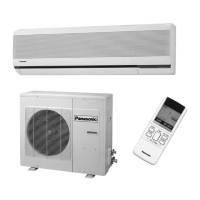Why does my Panasonic CS-A9BKP Air Conditioner emit water or steam?
- JJenna QuinnAug 19, 2025
During COOL/DRY operation, moisture in the air condenses into water on the cool surface of the outdoor unit piping, which causes dripping.

Why does my Panasonic CS-A9BKP Air Conditioner emit water or steam?
During COOL/DRY operation, moisture in the air condenses into water on the cool surface of the outdoor unit piping, which causes dripping.
What to do if my Panasonic Air Conditioner indoor unit leaks water?
Call the Dealer Immediately.
Why does my Panasonic Heat Pump Air Conditioner stop for 12 minutes during heating?
The Panasonic Heat Pump Air Conditioner may stop for about 12 minutes during heating to melt the frost that has accumulated on the outdoor unit. This is a defrosting operation which will take no longer than 12 minutes. Water drips from the outdoor unit during this process. Please wait until this operation ends.
Why does my Panasonic Air Conditioner smell?
The peculiar odor in the room may be a damp smell emitted by the wall, carpet, furniture, or clothing.
What to do if my Panasonic Air Conditioner has been restarted, but does not operate for 3 minutes?
This is a protective measure for your Panasonic Air Conditioner. Please wait until the air conditioner begins to operate.
Why does my Panasonic Air Conditioner make a water flowing sound?
This sound is the refrigerant flowing inside the Panasonic Air Conditioner.
Why does fog come out of my Panasonic CS-A9BKP?
Condensation occurs when the airflow from the Panasonic Air Conditioner cools the room, creating what appears to be fog.
Why does the indoor fan stop occasionally during Automatic Vertical Airflow setting on my Panasonic Air Conditioner?
This occurs to remove smells emitted by the surroundings.
Why does my Panasonic Heat Pump Air Conditioner's indoor fan run on and off during heating?
This is to prevent an undesired cooling effect during heating operation.
What to do if I hear abnormal noise during operation of my Panasonic Air Conditioner?
Call the Dealer Immediately.
| Brand | Panasonic |
|---|---|
| Model | CS-A9BKP |
| Category | Air Conditioner |
| Language | English |
Button that illuminates for convenience in the dark.
Senses indoor temperature to select the optimum mode.
Prevents room from getting too hot or too cold during sleep.
Reduces electrical power consumption.
Reaches desired room temperature quickly.
Panel designed for quick and easy cleaning.
Filters dust, smoke, particles; prevents bacteria growth.
Removes unpleasant odors and deodorizes room air.
Automatically restarts the unit after a power failure.
Advanced anti-rust coating on the outdoor unit condenser.
Uses R410A refrigerant for zero ozone depletion.
Guidelines and warnings for installing the air conditioner unit safely.
Essential safety guidelines for operating the air conditioner.
Identification of parts for the indoor air conditioning unit.
Identification of parts for the outdoor air conditioning unit.
Lists and identifies included accessories with the unit.
Identification of buttons and displays on the remote control.
Instructions on how to properly insert batteries into the remote.
Steps to prepare the indoor unit before operation.
Guide on setting the current time on the remote control.
Instructions on how to start and stop the air conditioner.
Steps to select different operating modes.
Guide on how to adjust the room temperature.
Adjusting fan speed and vertical/horizontal airflow.
Explanation of the cooling mode and its parameters.
Explanation of the auto mode and its parameters.
Explanation of the dry mode (dehumidification).
Explanation of the heating mode for heat pump models.
Explanations for defrosting and fan-only circulation modes.
How to use the sleep mode for comfortable sleeping.
Using economy and powerful modes for energy saving and quick operation.
Setting the timer to automatically turn the unit on.
Setting the timer to automatically turn the unit off.
Details on how timer functions work.
Instructions for cleaning the main unit and remote control.
Detailed steps for cleaning the air filters.
How to remove and clean the front panel.
Guidance on cleaning and when to replace air purifying filters.
Checks to perform before the cooling/heating season.
Procedures for storing the unit when not in use for extended periods.
Advice on professional inspection for optimal performance.
Using the auto operation button when the remote is lost.
How the unit restarts automatically after a power outage.
Important notes regarding timer settings after power loss.
Measures to protect the unit during thunderstorms.
Tips to save energy by adjusting temperature settings.
Importance of clean filters for cooling/heating efficiency.
Tips like keeping doors closed and avoiding direct sunlight.
Explains common sounds and occurrences during normal operation.
Steps to check when the unit is not operating correctly.
Issues that require immediate professional service.
Reminder to record important details like model and serial number.












